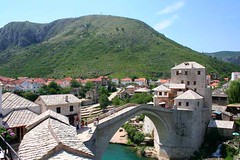
Denis, the architect who we stayed with, took us around Mostar in the morning. Surprisingly, and successfully, the city is waking up from the deranged nightmare and the pain of war, which is now being covered by layers of mundane daily life. The present carries the traces of shell explosions and bullets in the walls, through which the carefree greenery pushes towards light. The trauma contained in the walls is slowly changing into the virtual attraction of wild action stories, captivating the attention of incoming foreigners. We crossed one of the bridges to the Muslim side and entered the oldest mosque in the town. The multitude of Arab inscriptions, which we could not read, reminded us of musical notations or even of grafitti signatures, because of similarities in their shapes. We were told that even before the war physicaly started, there was a symbolic battle of signs and words, which eventually carried the aggression over to the streets. What does it then mean to inscribe and mark someone, a street, a house or a territory? The loyalty to family, tribe (called „pleme“ here), club, nation, or religion, became fateful for many who now rest together in the town center cemetery. The old bridge over Neretva carries a double meaning, it connects, but it also is a mark of the division between two sides. The balance of the letter M, as Mostar, is cracked by the memory of men mauled by the war who now walk on crutches.
Denis chose for himself the latinic letter L, not because it is in Latinic scrit, but because it reminds him of the right angle, which opens up the empry space for thinking and creativity.
Our journey continued towards Stolec through the village of Radmilja, where we stopped to see the necropolis of the Bogomils, a sect which was founded in Macedonia. The date of the founding as well as reasons are unknown…but somewhere, there is a connection with the story of our patrons, Cyril and Metodus. The possible connection? The area of the monumental necropolis was inland, on a highland plateau surrounded by mountians, probably hidden away from the Ottomans or the reach of the Monarchy. Typographically, the basreliefs on the large house-shaped tombs were reminiscent of neolithic or even Aztec markings. The tombs repeated a figure of a hunter or warrior with a raised right arm, which had a disproportionally large hand. Two tombs had inscriptions in a kind of cyrilic script.
We crossed the Klobuk mountain and the border to the independent republic of Montenegro at the height of 1060m, and then rode down the tobogan of narrow roads along the rugged mountain slopes all the way to the sea at the Boka Kotorska bay. With the luck in the left and right arms of our drivers, we were brought to Petrovac on the Sea, where we will stay for a few days.
No comments:
Post a Comment